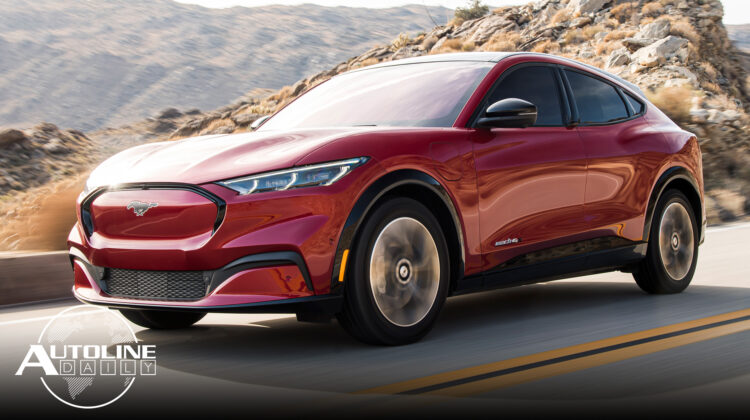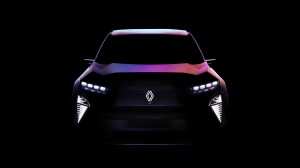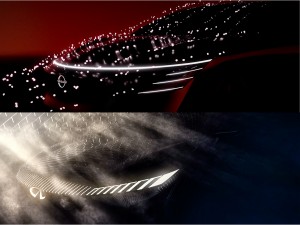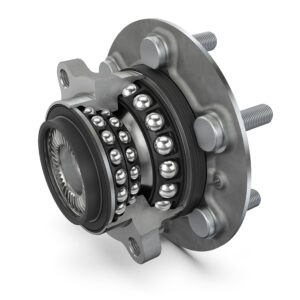
Listen to “AD #3264 – Mustang Mach-E Dethrones Tesla Model 3; China Cuts Subsidies and EV Sales Plummet; Driving Ford’s E-Transit” on Spreaker.
Follow us on social media:
Runtime: 10:58
0:08 Ford Mustang Mach-E Dethrones Tesla Model 3
0:56 More Chips Won’t Bring Down Car Prices
1:35 China Cuts Subsidies & EV Sales Plummet
2:29 Honda Jumps on The Mobility Bandwagon
3:16 Renault Posts First Profit In 3 Years
3:36 Nissan To Make EVs In Canton
4:26 Bridgestone To Make New Tires from Recycled Ones
5:26 Schaeffler Develops Bearings for EVs
6:16 Mercedes Shows Historical Testing Method
7:29 Driving Ford’s E-Transit
Visit our sponsors to thank them for their support of Autoline Daily: Bridgestone, Intrepid Control Systems and Schaeffler.
This is Autoline Daily, the show dedicated to enthusiasts of the global automotive industry.
FORD MUSTANG MACH-E DETHRONES TESLA MODEL 3
They must be popping the champagne corks at Ford’s headquarters. Consumer Reports just picked the Mustang Mach-E as the best electric car in the market. And it knocked the Tesla Model 3 off the top spot. CR was especially impressed with the driving monitoring system for the Mach-E’s BlueCruise semi-autonomous system. What CR liked is that it, and I quote “gives appropriate warnings when the driver looks away from the road for too long.” CR also liked the styling and the fact it’s fun to drive. Other vehicles that make the 10 Top Picks list this year include the Nissan Sentra and Rogue Sport, the Toyota Prius and RAV4 Prime, the Lexus RX, the Honda Accord and Ridgeline, the Subaru Forester, and the Kia Telluride.
MORE CHIPS WON’T BRING DOWN CAR PRICES
We didn’t think that new car prices were going to go down anytime soon. And now it’s official. Mike Manley, the CEO of AutoNation, which sells more cars and trucks than anyone else in the the U.S., says don’t expect big discounts on new vehicles going forward, even when production levels return to normal. New car prices have soared because of tight inventory caused by the chip shortage. And automakers and dealers are raking in record profits because they’re charging top dollar for everything. Earlier this week, we reported that 82% of new car buyers in January paid over MSRP.
CHINA CUTS SUBSIDIES & EV SALES PLUMMET
Even in China, car buyers are super sensitive to EV subsidies. Sales of NEVs, or New Energy Vehicles, fell over 18% last month when the Chinese government cut EV subsidies by 30%. NEVs include hybrids, PHEVs, BEVs and fuel cell vehicles. One reason sales dropped in January is that buyers rushed into showrooms in December to snap up an EV before the subsidies were cut. Here’s our Autoline Insight. China’s policy is to slowly wean consumers off subsidies because in the long run the government doesn’t want to keep footing the bill for sales of electric cars. And it wants to put more pressure on automakers to figure out how to compete on their own. To paraphrase Nietzsche the famous philosopher, “If it doesn’t kill you it will make you stronger.”
HONDA JUMPS ON THE MOBILITY BANDWAGON
OK, now it’s Honda’s turn. It too announced that it’s going to turn into a mobility company. It didn’t go into much detail but we can expect things like more electrification, OTAs, in-car purchases and mobility services. And Honda is picking a new leader to oversee the change. Chairman Toshiaki Mikoshiba is stepping down and is being replaced by Seiji Kuraishi.
RENAULT POSTS FIRST PROFIT IN 3 YEARS
Renault turned a profit for the first time in three years. It put €967 million on the bottom line for 2021. That’s over a billion dollars. And just to show it’s not going to follow everyone else with a battery electric car, it teased us with this concept that’s powered by an IC hydrogen engine.
NISSAN TO MAKE EVs IN CANTON
Meanwhile, Renault’s alliance partner Nissan is going to sink half a billion dollars into its assembly plant in Canton, Mississippi to make electric cars for itself and Infiniti. The money will go towards converting one of two assembly lines, so it can build both combustion and electric vehicles, as well as retraining 2,000 of its 5,000 employees and a new area for battery assembly. But Nissan is also looking for a new location to build a battery factory in the U.S., which it says should be soon. Here’s our Autoline Insight. Nissan already had a battery plant in the U.S. It opened in 2012 to make batteries for the Leaf, but it sold it off in 2018. It’s probably kicking itself because it sure sounds like it could use it now.
BRIDGESTONE TO MAKE NEW TIRES FROM RECYCLED ONES
Recycling tires just took a big step forward. Bridgestone and Japanese energy company, ENEOS, are launching a project to produce raw materials for tires from used tires. They’ll break down used tires to produce petrochemicals, which will then be used for synthetic tire production. They hope to start a large-scale trial production by 2030.
SCHAEFFLER DEVELOPS BEARINGS FOR EVs
Any time you can reduce friction in the powertrain or drivetrain in a vehicle, you make it more efficient. With electric cars, that means they get more range. So Schaeffler developed a wheel bearing, which attaches to the wheel hub, that uses a triple row ball bearing set. It’s specifically designed for electric powertrains, which usually use tapered rollers. Even though there are three rows of bearings, it’s the same size as standard two-row bearings. It’s also lighter and can transmit 50% more torque. Schaeffler says that switching from tapered rollers to ball bearings results in a 0.7 percent reduction in electricity consumption in the EPA’s FTP-75 test procedure. That’s the EPA test that determines EV range or fuel economy for cars with IC engines.
MERCEDES SHOWS HISTORICAL TESTING METHOD
Gathering vehicle data is way easier than it used to be. At the Mercedes-Benz Museum is a display highlighting what’s dubbed the measuring car, which was first used in 1960. The vehicle was modified to hold all kinds of testing equipment, which was big and heavy, along with two wicker chairs for engineers to sit in. It was then attached to a lead car via a cable that’s up to 30 meters or nearly 100 feet long. This way the lead car could transmit data back to the measuring car without the heavy equipment having an impact on the data. It was able to transmit 14 measured values, like suspension data, all at once to the measuring car, so engineers could see if changes to a vehicle were performing as intended. It sure does give a new meaning to vehicle-to-vehicle communication.
A quick correction here. Yesterday we reported that VOYAH was the first state-owned Chinese car company to start selling cars in Europe. Several of you sharp eyed viewers pointed out that SAIC, or the Shanghai Automotive Industry Company, has been selling cars in Europe under the MG brand. Thanks for catching that.
DRIVING FORD’S E-TRANSIT
When it comes to EVs at Ford, the Mach-E and Lightning are grabbing all the headlines. But an equally important EV for Ford doesn’t come with a blacked-out grille or a frunk. Our colleague Chad Kirchner from EV Pulse.com got some seat time in the electric version of the Transit van and shared this report.
We’re here in Northern California with Ford to learn all about Ford’s first commercial electric vehicle, the 2022 Ford E-Transit. The E-Transit is part of a greater Ford Pro initiative to make it easier for buyers to electrify their fleets and control their costs. Just like the normal Transit, the 2022 Ford E-Transit is available in three different lengths and three different roof heights, meaning there are no configuration sacrifices to going fully EV. Because the batteries are located in the floor, the cargo van has up to 488 cubic feet of capacity and up to 3,800 lbs. of payload. Ford claims up to 126 miles of range depending on roof height and length. E-Transit can charge up to 150 kilowatts, charging from 15 percent to 80 percent in approximately 34 minutes.
If you’re watching this as already a Transit customer, whether it’s personal or whether it’s a commercial, you’re probably wondering what that experience is like when the platform is electrified. Yes, all of the EV-centricness is here: instant torque when you put your foot down, regenerating electricity when you let off the accelerator or when you brake… but the biggest takeaway that I have is that it is a Transit. It drives like a gas or diesel Transit that you’ve already experienced, which means that it has a very car-like driving experience, even on one of these longer-wheelbase, higher-roof models like we’re in. Yes, it’s electrified, but you can replace your current Transit with this with very little additional cost other than replacing the vehicle.
Your next question is likely going to be: where am I going to charge it? For some business owners, that maybe something as simple as a couple of level two chargers at their office or at their work. They could also be building an entire custom depot with DC fast charging, as well as a level two charging.
The key element, though, is the management software that comes with it. It speaks to the power company so that it understands when the cheapest electricity is and will control when your vans are charging to save you the most amount of money by using the least amount of electricity that you need to use while still maintaining no downtime with your fleets.
The E-Transit cutaway starts at just under $45,000. A high roof, extended wheelbase cargo van starts at almost $54,400. For the full report on this van, click the link in the transcript or description box, or look for the EV Pulse channel on YouTube.
And that brings us to the end of today’s show, thanks for watching and have a great weekend.
Thanks to our partner for embedding Autoline Daily on its website: WardsAuto.com
Seamus and Sean McElroy cover the latest news in the automotive industry for Autoline Daily.












